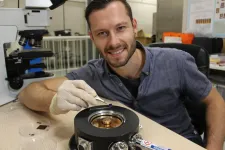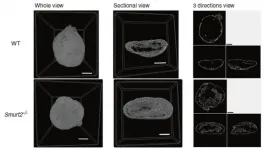Immune response to insulin could identify, help treat those at risk for Type 1 Diabetes
CU Anschutz researchers determine an important advancement in detecting the risk of T1D early in predisposed individuals, as well as the potential for intervention
2021-02-08
(Press-News.org) AURORA, Colo. (February 8, 2021) - Researchers from the Barbara Davis Center for Childhood Diabetes at the University of Colorado Anschutz Medical Campus have found that immune responses to insulin could help identify individuals most at risk for developing Type 1 diabetes.
The study, out recently in the Proceedings of the National Academy of Sciences, measured immune responses from individuals genetically predisposed to developing Type 1 diabetes (T1D) to naturally occurring insulin and hybrid insulin peptides. Since not all genetically predisposed individuals develop T1D, researchers sought to examine T-cell immune responses from the peripheral blood that could occur before the onset of clinical diabetes.
"We want to know why people develop T1D, and this research has helped provide a lot more information and data as to what it looks like when genetically at-risk individuals are headed towards clinical diagnosis," says Aaron Michels, MD, the study's lead researcher, Associate Professor of Medicine at CU Anschutz and researcher at the Barbara Davis Center. "Ideally, you want to treat a disease when it's active, so this is a need in our field to understand when people have an immune response directed against insulin producing cells."
Researchers collected blood samples from genetically at-risk adolescents every 6 months for two years. Inflammatory T-cell responses to hybrid insulin peptides correlated with worsening blood glucose measurements and progression to T1D development. The results indicate an important advancement in identifying the risk of T1D early as well as the potential for intervention.
"There are now therapies used in research studies that have delayed the onset of clinical type 1 diabetes," says Michels. "Patients with these specific immune responses, may benefit from immune intervention to delay T1D onset and possibly prevent it for years."
Furthermore, Michels says these results can lead to research beyond T1D. "Our work focused on diabetes, but this has implications for other autoimmune diseases. Understanding how the immune system responds can be crucial in trying to prevent diseases before clinical symptoms are present."
INFORMATION:
About the University of Colorado Anschutz Medical Campus
The University of Colorado Anschutz Medical Campus is a world-class medical destination at the forefront of transformative science, medicine, education, and patient care. The campus encompasses the University of Colorado health professional schools, more than 60 centers and institutes, and two nationally ranked independent hospitals that treat more than two million adult and pediatric patients each year. Innovative, interconnected and highly collaborative, together we deliver life-changing treatments, patient care, professional training, and conduct world-renowned research. For more information, visit http://www.cuanschutz.edu.
ELSE PRESS RELEASES FROM THIS DATE:
2021-02-08
An international team of scientists has invented the equivalent of body armour for extremely fragile quantum systems, which will make them robust enough to be used as the basis for a new generation of low-energy electronics.
The scientists applied the armour by gently squashing droplets of liquid metal gallium onto the materials, coating them with gallium oxide.
Protection is crucial for thin materials such as graphene, which are only a single atom thick - essentially two-dimensional (2D) - and so are easily damaged by conventional layering technology, said Matthias Wurdack, who is the lead author of the group's publication in Advanced Materials.
"The protective coating ...
2021-02-08
A framework designed to provide detailed information on agricultural groundwater use in arid regions has been developed by KAUST researchers in collaboration with the Saudi Ministry of Environment Water and Agriculture (MEWA).
"Groundwater is a precious resource, but we don't pay for it to grow our food, we just pump it out," says Oliver López, who worked on the project with KAUST's Matthew McCabe and co-workers. "When something is free, we are less likely to keep track of it, but it is critical that we measure groundwater extraction because it impacts both food and water security, not just regionally, but globally."
Saudi Arabia's farmland is often irrigated via center pivots that tap underground aquifer sources. The team has built a powerful tool ...
2021-02-08
Osaka, Japan - Bone morphogenetic protein (BMP) has a strong osteogenic (bone forming) ability. BMP has already been clinically applied to spinal fusion and non-union fractures. However, dose-dependent side effects related to BMP use, such as inflammatory reactions at the administration site, prevent widespread use.
For safe use, it was necessary to clarify how the BMP signaling pathway is controlled. In a report published in Bone Research, a group of researchers from Osaka University and Ehime University has recently identified a novel role for the protein Smurf2 in regulating bone formation by BMP.
When BMP transmits its message within cells, it can induce rapid bone formation. Previous studies have shown that Smurf2 can control another similar ...
2021-02-08
Lithium metal batteries could double the amount of energy held by lithium-ion batteries, if only their anodes didn't break down into small pieces when they were used.
Now, researchers led by Prof. CUI Guanglei from the Qingdao Institute of Bioenergy and Bioprocess Technology (QIBEBT) of the Chinese Academy of Sciences (CAS) have identified what causes lithium metal batteries (LMBs) to "self-destruct" and proposed a way to prevent it. The findings were published in Angewandte Chemie on Jan. 19.
This offers hope of radically enhancing the energy held in batteries without any increase in their size, and at reduced cost.
In fact, LMBs were the original concept for long-lasting ...
2021-02-08
Tiny nanoparticles can be furnished with dyes and could be used for new imaging techniques, as chemists and physicists at Martin Luther University Halle-Wittenberg (MLU) show in a recent study. The researchers have also been the first to fully determine the particles' internal structure. Their results were published in the renowned journal Angewandte Chemie.
Single-chain nanoparticles (SCNPs) are an attractive material for chemical and biomedical applications. They are created from just a single chain of molecules that folds into a particle whose circumference measures three to five nanometres. "Because they are so small, they can travel everywhere in the human body and be used for a wide variety of purposes," says Professor Wolfgang ...
2021-02-08
In humans, differences in personalities have been evident since the ancient times. Personality in animals has long been ignored, but recently this question has received increasing research interest as it has been realized that personality has evolutionary and ecological significance. An international team of behavioral biologists from Austria, Brazil and the Netherlands, with Vedrana Å lipogor from the University of Vienna as leading author of the study, designed a set of tasks to assess personality of common marmosets. These results have just been published in American Journal of Primatology.
Marmosets are small highly social New World monkeys that parallel humans in their social organization, as they live in cohesive ...
2021-02-08
Researchers from the Institute of Environmental Science and Technology of the Universitat Autònoma de Barcelona (ICTA-UAB) warn of the impact the current tourism model in the Mediterranean islands has on the production of marine litter on beaches, and recommend taking advantage of the situation generated by the Covid19 pandemic to rethink a new more sustainable model. The research, recently published in the journal Scientific Reports, shows that the recreational use of Mediterranean island beaches during the summer is responsible for up to 80% of the marine litter accumulating on those beaches, and generates huge amounts of microplastics through the fragmentation ...
2021-02-08
A German-Chinese research team has found a new synthetic route to produce biofuel from biomass. The chemists converted the substance 5-hydroxymethylfurfural (HMF) produced from biomass into 2,5-dimethylfuran (DMF), which could be suitable as a biofuel. Compared to previous methods, they achieved a higher yield and selectivity under milder reaction conditions. The team led by Dr. Baoxiang Peng and Professor Martin Muhler from the Laboratory of Industrial Chemistry at Ruhr-Universität Bochum (RUB) and the group led by Professor Christof Hättig from the RUB Chair for Theoretical Chemistry described the method together with colleagues from Changzhou, ...
2021-02-08
Solar energy is one of the most abundant renewable energy sources, and effective solar technologies have great potential to alleviate the grand challenges of rising global energy demands, while reducing associated emissions. Solar energy is capable of satisfying the electrical and thermal-energy needs of diverse end-users by means of photovoltaic (PV) and solar thermal (ST) technologies, respectively. Recently, hybrid photovoltaic-thermal (PVT) concepts have been proposed that synergistically combine the benefits of PV and ST technologies, and are capable of generating both electricity and useful heat simultaneously from the same area and component.
Spectral splitting is an emerging approach for designing high-performance PVT solar collectors, which employ advanced designs ...
2021-02-08
The molecular details of how SARS-CoV-2 enters cells and infects them are still not clear. Researchers at Uppsala University have tested the bioinformatic predictions made by another research group and have identified receptors that could be important players in the process. The results are presented in the journal Science Signaling and at the AAAS Annual Meeting held this week.
The spike protein of SARS-CoV-2 binds the protein ACE2 on the outside of the human cell. This triggers a series of events that leads to invasion of the cell by the virus. The molecular details of this process have remained obscure ...
LAST 30 PRESS RELEASES:
[Press-News.org] Immune response to insulin could identify, help treat those at risk for Type 1 Diabetes
CU Anschutz researchers determine an important advancement in detecting the risk of T1D early in predisposed individuals, as well as the potential for intervention





